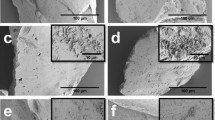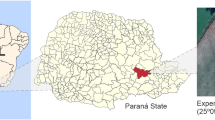Abstract
The goal of this study is to clarify the surface-chemical and microphysical variables that influence bacterial spore transport through soil, thereby defining the factors that may affect spore transport velocity. Bacillus cereus spores were continuously monitored in a soil column under saturated conditions with experimental variations in soil grain size (0.359 and 0.718 mm), pH (7.2 and 8.5), and water flow rate (1.3 and 3.0 mL/min). Increasing soil grain size, flow rate, and pH resulted in enhanced spore movement. Spore transport increased 82% when soil grain size was doubled. An increase in effluent flow rate from 1.3 to 3.0 mL/min increased spore movement by 71%. An increase in pH increased spore transport by 53%. The increase in hydrodynamic forces resulting from the larger grain size soil and higher flow rate functioned to overcome the hydrophobic nature of the spore’s coat, and the interparticle bonding forces between the spore and soil particles.





Similar content being viewed by others
References
Alley, W. M., Reilly, T. E., & Franke, O. L. (1999). Sustainability of groundwater resources. U.S. geological survey circular 1186. Denver: U.S. Geological Survey.
Anderson, I., Sorokin, A., & Kapatral, V. (2005). Comparative genome analysis of Bacillus cereus group genomes with Bacillus subtilis. FEMS Microbiology Letters, 250, 175–184.
Arakawa, E. T., Lavrik, N. V., & Datskos, P. G. (2003). Detection of anthrax simulants with microcalorimetric spectroscopy: Bacillus subtilis and Bacillus cereus spores. Applied Optics, 42, 1757–1762.
Bales, R. C., Li, S., Maguire, K. M., Yahya, M. T., Gerba, C. P., & Harvey, R. W. (1995). Virus and bacteria transport in a sandy aquifer, Cape Cod, MA. Ground Water, 33, 653–661.
Craun, G. F., & Calderon, R. L. (1997). Microbial risks in groundwater systems: Epidemiology of waterborne outbreaks, in Under the Microscope: Examining microbes in groundwater. Denver, CO: American Water Works Research Foundation.
DeFlaun, M. F., & Condee, C. W. (1997). Electrokinetic transport of bacteria. Journal of Hazardous Materials, 55, 263–277.
Gannon, J. T., Tan, Y., Baveye, P., & Alexander, M. (1991). Effect of sodium chloride on transport of bacteria in a saturated aquifer material. Applied Environmental Microbiology, 57, 2497–2501.
Gerba, C. P., & Bales, R. C. (1990). Virus transport in the subsurface. In C. B. Fliermans, & T. C. Hazen (Eds.), Paper presented at the First International Symposium on Microbiology of the Deep Subsurface, Orlando, FL.
Husmark, U., & Ronner, U. (1990). Forces involved in adhesion of Bacillus cereus spores to surfaces under different environmental conditions. Journal of Applied Bacteriology, 69, 557–562.
Husmark, U., & Ronner, U. (1992). The influence of hydrophobic, electrostatic and morphological properties on adhesion of Bacillus spores. Biofouling, 5, 335–344.
Huysman, F., & Verstraete, W. (1993). Water-facilitated transport of bacteria in unsaturated soil columns: influence of inoculation and irrigation methods. Soil Biology & Biochemistry, 25, 91–97.
Kinoshita, T., Bales, R. C., Yahya, M. T., & Gerba, C. P. (1993). Bacteria transport in a porous medium: retention of bacillus and pseudomonas on silica surfaces. Water Research, 27, 1295–1301.
Klavenes, A., Stalhiem, T., Sjovold, O., Josefsen, K., & Granum, P. E. (2002). Attachment of Bacillus cereus spores with and without appendages to stainless steel surfaces. Trans I Chem E, 80, 312–318.
Lindqvist, R., & Bengtsson, G. (1995). Diffusion-limited and chemical-interaction-dependent sorption of soil bacteria and microspheres. Soil Biology & Biochemistry, 27, 941–948.
Loveland, J. P., Ryan, J. N., Amy, G. L., & Harvey, R. W. (1996). The reversibility of virus attachment to mineral surfaces. Colloids and Surfaces A: Physicochemical and Engineering Aspects, 107, 205–221.
Pang, L., Close, M. E., Goltz, M., Noonan, M., & Sinton, L. (2005). Filtration and transport of Bacillus subtilis spores and the F-RNA phase MS2 in a coarse alluvial gravel aquifer: Implication in the estimation of setback distances. Journal of Contaminant Hydrology, 77, 165–194.
Ricca, E., Henriques, A. O., & Cutting, S. M. (2004). Bacterial Spore Formers: Probiotics and Emerging Applications. Horizon Bioscience. pp. 244.
Schaeffer, P., Millet, J., & Aubert, J. -P. (1965). Catabolic repression of bacterial sporulation. Paper presented at the National Academy of Sciences (PNAS).
Schijven, J. F., de Bruin, H. A. M., Hassanizadeh, S. M., & de Roda Husman, A. M. (2003). Bacteriophages and clostridium spores as indicator organisms for removal of pathogens by passage through saturated dune sand. Water Research, 37, 2186–2194.
Sinton, L. W., Noonan, M. J., Finlay, R. K., Pang, L., & Close, M. E. (2000). Transport and attenuation of bacteria and bacteriophages in an alluvial gravel aquifer. New Zealand Journal of Marine and Freshwater Research, 34, 175–186.
Stalheim, T., & Granum, P. E. (2001). Characterization of spore appendages from Bacillus cereus strains. Journal of Applied Microbiology, 91, 839–845.
Tan, Y., Gannon, J. T., Baveye, P., & Alexander, M. (1994). Transport of bacteria in an aquifer sand: Experiments and model simulations. Water resources research, 30, 3243–3252.
Taylor, R., Cronin, A., Pedley, S., Barker, J., & Atkinson, T. (2004). The implications of groundwater velocity variations on microbial transport and wellhead protection—review of field evidence. FEMS Microbiology Ecology, 49, 17–26.
Trevors, J. T., van Elsas, J. D., van Overbeek, L. S., & Starodub, M. E. (1990). Transport of a genetically engineered Pseudomonas fluorescens strain through a soil microcosm. Applied and Environmental Microbiology, 56, 401–408.
Van Elsas, J. D., Trevors, J. T., & van Overbeek, L. S. (1991). Influence of soil properties on the vertical movement of genetically-marked Pseudomonas fluorescens through large soil microcosms. Biology and Fertility of Soils, 10, 249–255.
Acknowledgements
The authors gratefully acknowledge the Homeland Security Grant from the Office of the Vice President for Research of the University of Arizona for the support of this research.
Author information
Authors and Affiliations
Corresponding author
Rights and permissions
About this article
Cite this article
Kim, M., Boone, S.A. & Gerba, C.P. Factors that Influence the Transport of Bacillus cereus Spores through Sand. Water Air Soil Pollut 199, 151–157 (2009). https://doi.org/10.1007/s11270-008-9867-9
Received:
Accepted:
Published:
Issue Date:
DOI: https://doi.org/10.1007/s11270-008-9867-9




